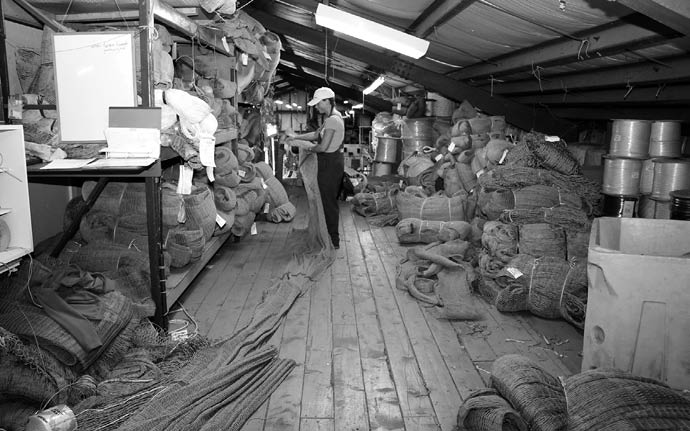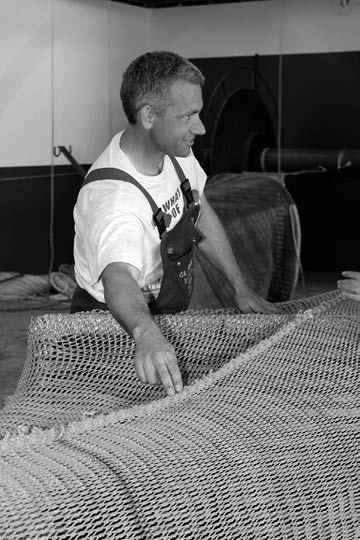The Harbour Grace Trawl Rigger
“To me the sea is a continual miracle; the fishes that swim—the rocks—the motion of the waves—the ships, with men in them. What stranger miracles are there?”
— Walt Whitman
If they ever make a movie about Anne of Green Gables in her forties, married with children, then Kim Pike would be the perfect Anne.
The forty-two-year-old mother of two from Harbour Grace, Newfoundland, has striking red hair that is often braided, along with greenish-blue eyes and freckles—just like Anne.
But unlike Anne, the fictional character in Lucy Maude Montgomery’s famous book, Anne of Green Gables, Kim didn’t grow up on a farm in PEI, and she knows a lot more about fish than potatoes—or at least she knows a lot more fishermen than farmers.
Kim is a trawl rigger.
For the uninitiated, a trawl rigger is a person who constructs or builds nets or trawls—those that Kim Pike and her colleagues at Hampidjan Canada Ltd. in Spaniard’s Bay work on are those very long nets that are towed behind large fishing vessels.
Most trawls are different and, in many cases, custom-made, depending on the requirements of each vessel owner or captain and what species they are fishing.
Kim says some fishermen prefer a stronger or heavier-gauge rope or a slightly different mesh than others, adding that of course there are limits and restrictions in place by government that must also be followed.
Among the most efficient of all fishing gear, trawls are towed behind the vessel and used for the capture of species such as shrimp, redfish, cod, flounder, skate, and hake. The mouth of the trawl is the widest part, and the net tapers smaller toward the end, often more than 100 feet.

Kim working with the miles of twine in the Hampidjan warehouse in Spaniard’s Bay.
Kim started working with the company eight years ago, when it was called Rope, Net and Twine. She didn’t have any idea what the job entailed when she responded to an ad in a newspaper. All she knew was that it was close to home, and that was what first attracted her to check it out.
She had worked at higher-paying jobs, but being the mom of two young boys, she didn’t like the long-distance commute, in case her children needed her—especially since her husband is in the construction industry and often works on projects that keep him away from home.

Kim Pike
Kim admits that she didn’t even know what a trawl was at the time and was honest about it with management during her interview for the position, but they responded positively, saying it was nice to have a totally fresh person who could learn the ropes, literally, and learn it the proper way without any preconceived notions of how it should be done.
“I really liked the idea of working there because it meant I would be active and not tied to a desk.”
Growing up in Riverhead, Harbour Grace, Kim was an active child and teenager. “For example, I used to swim a lot—wherever there was a hole of water, I would be in it,” she says, adding that the job means that she is in constant motion.
Hampidjan is an Icelandic company and owns trawl-making and fishing-supplies companies internationally. But the operation in Spaniard’s Bay was known as “Bob Kelly’s” before the Icelanders moved in, and for most fishermen it still is, no matter what sign is over the door.

Kim’s boss, Dave Kelly, working with Kim on the construction of a new net.
There was never a company called Bob Kelly’s, but Mr. Kelly is one of the best-known and most respected names in the fishing supply industry in Newfoundland, and fishermen didn’t care what he called the company—it was simply Bob Kelly’s.
If you check the notices in the Navigator magazine today you will still find notices reading “Bob Kelly trawl doors” or “Bob Kelly trawls wanted” to buy or for sale.
Bob put his own stamp on equipment, either through designing his own or modifying existing concepts.
I invited Bob to be my guest for this story, but he is a very modest man who shuns the limelight. However, it was through that process that I met Kim Pike. Bob still has a hand in the business, but his son David Kelly is in charge now.
Building or rigging a trawl is complex work. All of the pieces have to be measured, cut, and then the mesh is hand-sewn together. Each step in the process has its own particular method to tie the knots, splice the ropes, and piece together all the mesh, twine, and rope to make a functional net.
It takes a team of five or six experienced people three days to complete one net—which seems fairly fast to an untrained eye looking at the huge pile of material that is required to be laced, sewn together, and “rigged.”
Not long ago, men did most of the net rigging. Kim says when she started in the business, there was only one female rigger with the company in Spaniard’s Bay. Now about half of them are women.
“When fishermen come into the store, they often seem a little surprised to see women working on the trawls, but after they talk to us for a few minutes, there is no problem—all they want is a good quality product, and that’s what we want to give them,” Kim says.
Kim enjoys her work, and it shows. She smiles—a lot. “Monday morning is always a nice day of the week for me,” she says.
An outgoing and affable woman, Kim is very comfortable talking to anyone, and that comfort makes her clients also feel at ease.
Most fishermen like to tease and joke with their friends, but we’re told that Kim, a jovial person, can dish it out just as well as she takes it. We also hear through the grapevine that Kim, owner of several German shepherds, is an animal lover and does some rather strange things to keep even the lowliest animal from harm. Someone said she’s been known to pick up spiders from the floor and carry them to safety outside.
The Pike household is a busy one. With sons aged sixteen and nineteen, Kim doesn’t have a lot of spare time. The family enjoys outdoor activities during all seasons, and music is a significant part of the daily activity, too, especially for her husband, Neil, and eldest son, Ryan.
Neil plays bass, and Ryan is a fine drummer. Kim admits that although she is outgoing, she was shy when she was younger and is still a little bashful, and while some of her family members encourage her to sing, she prefers to keep her vocalizing to herself or at least inside the four walls of home. “I don’t like people looking at me while I sing,” she says.
Known for her good work ethic, ability to work well with colleagues, coupled with her optimistic and positive outlook in dealing with any issue, Kim Pike will never have to sing for her supper.